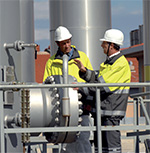
In order to create shared value, Snam is committed to furthering sustainable development throughout its transportation, dispatching, regasification, storage and distribution processes. Creating shared value is a fundamental part of Snam’s method of operation and it focuses on specific company business areas in which the potential for the creation of joint value for both the Company and stakeholders is greater.
In the territory, for the territory
Territory is a fundamental element for the Company to be able to prosper. Territory is to be understood both in the sense of the natural resources to which the Company has access with its infrastructure assets to ensure supply and in the sense of the anthropic resources that populate it. Precisely for these basic reasons, Snam is in a privileged position to explore the concept of shared value (see box). The group holds a central position in the value chain, rising up as a strategic resource for the country. Its relationship of osmosis with the Italian territory, its broad geographical presence and its homogenous offerings throughout the country enable Snam to rank among the main drivers of Italian development.
Moreover the Company holds a broad array of tangible and intangible assets: it owns technological infrastructure, is a major buyer of products and services, encourages demand for some specialised technologies, and contains powerful know-how on technologies, safety and security, and complex project management.
The mission
Shared value is implicitly innate in the corporate mission, which identifies the Snam group’s objective as “the creation of value capable of meeting shareholder expectations, achieved by providing services to its customers under conditions of the utmost safety and reliability and ensuring the development of infrastructure and the flexibility of the gas system in Italy, in support of the development of competition and security in the supply system. The Snam group pursues a model of sustainable growth over time, centred on careful evaluation of environmental impacts and on the development of new and more efficient technologies. In order to successfully achieve its objectives, the entire group wagers on the wealth of skills of its people and their continual honing”.

Identifying shared value: the analysis conducted at the Company
In the early months of 2012, Snam launched a process of structured analysis of its basic business characteristics consistent with the shared value approach, to reach a definition of a summary model that would allow the Company to systematically review its core and support processes according to that approach.
Shared value is the lens through which some projects and processes already under way at the Company were identified, viewed and classified. The process of identifying, evaluating and exploiting shared value activities falls within the process of continual improvement undertaken by Snam.
The purpose of the analysis process was to:
- understand whether (and how) shared value is a useful conceptual framework and operating tool for Sustainability 2.0 at Snam;
- develop a strategy and an operating approach for shared value;
- improve Snam’s sustainability reporting.
Sixteen in-depth interviews were conducted with corporate contact people in different functions aimed at sharing the project approach and at exploring the subject, identifying current and potential projects, both at the corporate level (Snam S.p.A.) and at the subsidiaries, Snam Rete Gas, Stogit, Italgas and GNL Italia.
It was thus possible to map about 60 processes and projects with potential shared value. The congruence of each project with the main corporate processes was evaluated, identifying the leader process, the contributory processes and the beneficiary processes.
The subject of shared value is on a path of natural continuity with the measures implemented in the last two years in terms of sustainability, starting from the mapping of stakeholders and from the projects deriving from it and consequently carried out. For a description of these (e.g. the workshop with suppliers on sustainability issues, the Social Impact Assessment applied to investment projects, the local stakeholder satisfaction process concerning the execution of the Malborghetto – Bordano methane pipeline, and the strategy of engagement with non-profit organisations), the reader is referred to the 2011 Sustainability Report.
In short, it was possible to identify the following at the Company:
- significant congruence between shared value and corporate DNA ;
- a strong interest in the subject of shared value and its possible application. The cultural fabric with regard to Sustainability 2.0 issues appears very ingrained at the Company and widespread at different levels;
- unexpressed potential on the subject of shared value; therefore, the review already under way of some processes through this lens should have very low marginal costs.



